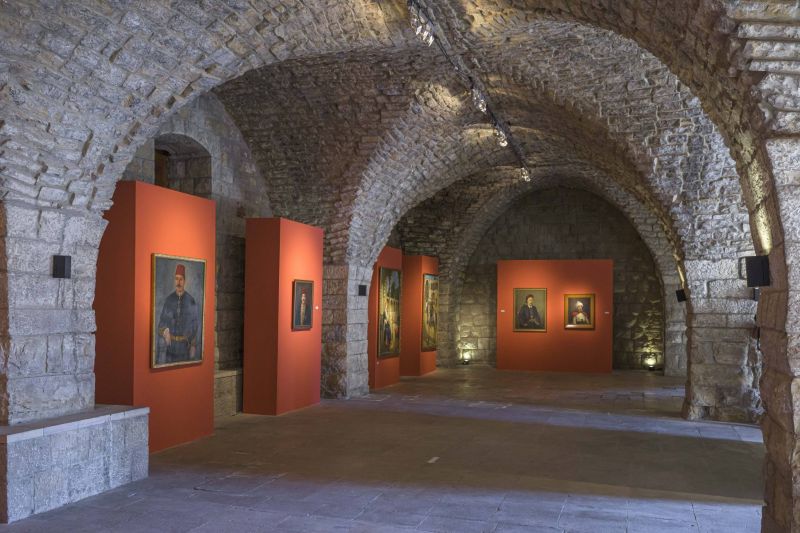In Beiteddine, Saleh Barakat's Three Events!
At the Beiteddine Palace and on the sidelines of the 2022 festival, Saleh Barakat presents three events: "The Forgotten Beiteddine", an astonishing collection of drawings and paintings from the 19th and 20th centuries, "Sculptures at the Court", a tribute to the great sculptors deceased Lebanese, as well as more than 200 works to honor nature.
Aware that the Beiteddine Festival, since its creation, attracts an enthusiastic public and works as an important economic dynamic in the region, Nora Joumblatt has decided, this year, to do things differently.
It has made access to the festival free in order to allow all Lebanese, paralyzed by the economic crisis, to treat themselves to a moment of pleasure, the latter having become an inaccessible luxury.
In addition to this decision, she contacted Saleh Barakat, a great Lebanese gallery owner, to put in place an innovative idea within this festival. Beiteddine Palace will offer the public this year three installations under the title: The Forgotten of Beiteddine, Sculptures at the Court (Sculptures at the Court) and Tabi3é, mech tabi3é (Natural, not natural).
When the past meets the present
“I thought a lot, confides the gallery owner, to create an exhibition that made sense. It first came to my mind to denounce the violence suffered by nature in general and the animal species in particular in Lebanon; the systematic killing of birds as they passed over Lebanese territory on their way from Madagascar to Poland was my starting point, the forests that were burned and the trees that were felled. Ginane Makki Bacho, a rebellious and committed artist, but also a woman of passion, with her burned forests, Hassan Samad, who has listed 23 species of birds killed each year, Tagreed Darghouth and his severed trunks, and Jack Dabaghian and his fight for the Cedars of Lebanon were the artists who responded well to this project. "But, continues Saleh Barakat, in order not to add distress to the distress of the Lebanese, I decided to reverse the visitor's route and first shine the spotlight on nature in all its splendor to end the wandering by a sad observation on what Lebanon is doing with what God had given us most beautiful. »
The visitor will cross the galleries of the palace of Beiteddine to admire more than 200 works glorifying nature and arrive, at the end of the journey, to become aware of the damage it suffers in our country. At the entrance to the galleries, Saleh Barakat had the idea of exhibiting the palace collection. Completely forgotten and in a lamentable state, it is corroded by humidity and mold and neglected by the State. These paintings, with a strange history, will constitute the Forgotten of Beiteddine. The gallery owner-curator offers them a setting commensurate with their value and thus exhibits 20 museum paintings. His primary ambition was to attract the attention of the outgoing Minister of Culture, Mohammad Mortada, to obtain the restoration of the paintings and give them a second life. "My greatest satisfaction is to have succeeded in this bet", he confides. Indeed, the decision was taken by the Minister of Culture to recover the works and restore them. Finally, in the courtyard, Saleh Barakat has decided to install pieces by great sculptors who have disappeared such as Saloua Raouda Choukair and the three Basbous brothers: Alfred, Michel and Joseph.
Art within everyone's reach
Pedagogy and mediation have always been at the heart of Saleh Barakat's artistic issues. Beyond the simple fact of organizing an exhibition, the latter was first delighted by the idea of investing in a public space. “A work can exist in an institution or a gallery as a work of art, he says, but sometimes, if you immediately transpose it into a public space, it reads differently. The context of the public space, of the real world, is very different from that of the institution or the gallery. Art in the public space also means bringing the culture of an era to a greater number of people, a culture to which this great number did not necessarily have access. It happened to me during the clash to witness the passage of more than forty tourists who stopped by simple curiosity. At a time when all landmarks are annihilated and when references are confused, when Lebanon is sinking into chaos and losing its intrinsic identity, the collaboration of energies and knowledge is necessary to restore culture to its letters of nobility. . Art is not reserved for one group. We cannot stay in our corner and work as if we were in an isolated bunker. We have to relearn how to behave according to current events and the contexts in which we find ourselves,” says the gallerist.
Investing in a public space is a very interesting approach for Saleh Barakat. It produces movement in places, restores life and humanity by creating imagination where the norm is. Its complexity is its strength, generosity its driving force. “I hope that Lebanese gallery owners will be inspired and tempted to repeat the experience,” he admits. Why not in the presidential palace or in the ruins of Baalbeck? I would so much like art to be useful before simply being. As the visitor strolls, the artistic interventions will mark the spaces, magnify or transform perceptions, but will also arouse everyone's curiosity, and even fuel public debate. Thus, more or less explicitly, art can participate in the public life of the space it occupies. As a vector of dialogue.
Source



